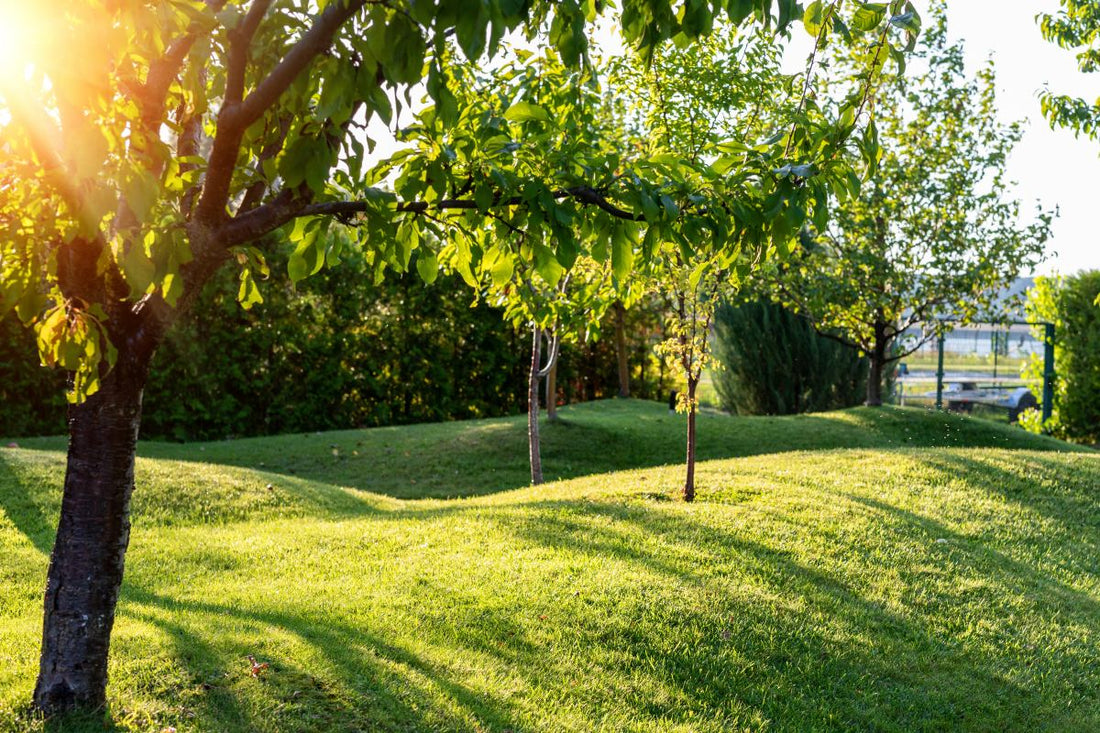Every successful lawn starts with timing, and timing begins with temperature. For homeowners asking what temperature kills grass seed, the answer is critical: grass seed is highly sensitive to extremes.
Too much cold or heat during germination can prevent sprouting, weaken seedlings, or wipe out an entire seeding project.
Understanding temperature thresholds, along with soil conditions, seed type, and seasonal timing, allows DIY homeowners to plant with confidence and avoid wasted time and money.
What this article covers:
- Why Temperature Matters for Grass Seed Germination
- Temperature Ranges for Cool-Season Grass Seed
- Temperature Ranges for Warm-Season Grass Seed
- How Extreme Cold Affects Grass Seed
- How Extreme Heat Affects Grass Seed
- How to Protect Grass Seed From Temperature Stress
Why Temperature Matters for Grass Seed Germination
Grass seed doesn't germinate based on calendar dates. It responds to soil temperature, not air temperature, which makes monitoring your soil more reliable than guessing based on the weather.
If you seed too early in spring, the soil may still be too cold. The result is delayed germination, or worse, seeds killed outright by frost.
If you seed too late in summer, excessive soil heat dries out seedlings before they establish. Both situations waste money and effort.
That's why knowing safe germination ranges is essential for any DIY homeowner. Whether you're working with cool-season fescues or warm-season Bermuda, matching the seed to the right temperature window is the single best way to guarantee success.
Different types of grass seed may tolerate stress differently, but all of them require the right soil range to sprout strong and healthy.
In our experience, homeowners get the most reliable results when they use a simple soil thermometer instead of relying on air temperature or a calendar.
Checking soil at the root zone (about 2 inches deep) gives a true reading of germination conditions and can save you from reseeding an entire lawn that never takes.

Temperature Ranges for Cool-Season Grass Seed
Cool-season grasses dominate in northern climates and transition zones. Their roots thrive in cooler soil, making spring and fall the prime windows for planting.
- Optimal germination range: 50–65°F soil temperature
- Below 40°F: Seed may stay dormant or die if frost persists
- Above 85°F: Germination falls sharply, with higher risks of fungal disease and drought stress
Common cool-season grasses include Kentucky bluegrass, perennial ryegrass, and multiple types of fescue grass.
Fescues in particular are prized for their adaptability, but even they fail if planted outside their optimal temperature window.
For reliable results, seed cool-season grasses in early fall or early spring, avoiding both frost and peak summer heat.
We've seen the best establishment when homeowners combine timing with light topdressing (such as compost, peatmoss, or straw mulch) to hold soil moisture steady.
Even in the correct temperature range, fluctuating moisture is the number one reason seedlings fail. Covering the seed helps lock in both temperature stability and germination success.
Temperature Ranges for Warm-Season Grass Seed
Warm-season grasses are designed for southern climates where summer heat dominates. They demand warm soil to sprout and perform poorly in cooler conditions.
- Optimal germination range: 65–75°F soil temperature
- Below 60°F: Seeds struggle or rot without sprouting
- Above 95°F: Soil becomes so hot that seeds dry out and die before rooting
Examples include Bermuda, zoysia, and centipede grass. For southern lawns, planting windows open in late spring and close by early summer. Seeding during midsummer heat or early spring chill is almost always a losing battle.
Some warm-season grasses, like the different types of St. Augustine grass, are rarely seeded at all. St. Augustine is typically established through sod or plugs because its seed is unreliable.

How Extreme Cold Affects Grass Seed
Cold weather is one of the most common reasons seeding projects fail. While dormant seeding (planting just before winter) is sometimes used strategically, it carries risks.
- Frost heave can dislodge seed from the soil, leaving it vulnerable to wind, birds, or runoff.
- If temperatures dip below 40°F before germination, seeds often die or stay dormant until spring.
- Newly sprouted seedlings are highly vulnerable to frost and almost never survive extended freezes.
For northern homeowners, this is why when to seed lawn matters so much. Plant too late in the fall and you may lose your investment. Plant at the right soil temperature window, and your seed has time to root before winter sets in.
From decades of observation, the most reliable way to push fall seeding late into the season is to pair it with a protective mulch cover, such as Seed Aide Cover Grow.
This not only insulates the soil against sudden cold snaps but also helps hold seed in place against frost heave.
It's a technique we used on estates where bare spots had to be repaired before winter, and it works just as well for DIY homeowners.
How Extreme Heat Affects Grass Seed
Just as cold threatens germination, excessive heat can be even more destructive. Soil temperatures above 95°F essentially “cook” grass seed, drying it out before it can take root.
Even if germination begins, young seedlings wilt under heat stress, leaving bare patches that invite weeds.
Other risks of hot-weather seeding include:
- Increased weed competition, since weeds thrive in hot soil.
- Higher risk of fungal disease, fueled by humid summer conditions.
- Shallow rooting, which weakens turf long-term.
This is why midsummer is rarely the right time to seed.
At Lawn Synergy, we recommend waiting for the soil to cool before reseeding cool-season lawns or targeting late spring for warm-season grasses, when conditions favor establishment.

How to Protect Grass Seed From Temperature Stress
Planting in the correct temperature range is the first step. Protecting the seed through careful preparation and maintenance ensures it survives unpredictable swings in weather.
Choose the Right Planting Window
- Cool-season grasses: Seed in early fall (best) or early spring.
- Warm-season grasses: Seed in late spring through early summer, once the soil is consistently warm.
Use Mulch or Coverings for Protection
Covering seed with products like Seed Aide Cover Grow helps retain moisture, regulate soil temperature, and protect against erosion or washout. Even a thin layer of straw can buffer against sudden cold snaps or heat.
Water Consistently
New grass seed is most vulnerable to drying out. Water lightly and frequently until seedlings sprout, then transition to deep, less frequent watering to encourage strong roots.
In hot or dry spells, this difference in watering often decides whether seedlings survive.
Support With Fertilizer and Soil Testing
Starting strong means feeding the seed properly. A balanced fertilizer such as Starter Fertilizer 15-20-10 supports early root development, while soil testing ensures pH and nutrients are aligned with your grass choice.
We've seen countless homeowners fail not because of the seed itself, but because the soil foundation wasn't corrected before planting.

Estate-Care Tip
From our decades of experience, one overlooked strategy is mowing height after establishment.
Keeping grass slightly taller (around 3 to 3.5 inches) helps shade the soil, regulate surface temperature, and protect seedlings from stress. It's a small adjustment that makes a big difference for long-term turf health.
Conclusion
The answer to what temperature kills grass seed depends on the type of grass you're planting, but the principle is always the same: extreme cold or heat stops germination and wastes your effort.
Cool-season grasses germinate best between 50 and 65°F, while warm-season grasses thrive between 65 and 75°F. Planting outside those ranges risks losing seed to frost, heat, or disease.
At Lawn Synergy, we help DIY homeowners eliminate the guesswork.
With professional-grade grass seed blends, you can plant at the right time and grow a lawn that rivals estate properties.
Whether you're in Florida, North Carolina, or anywhere in between, our products and expertise ensure your lawn thrives season after season.
Ready to learn more about lawn care? Check out these articles:

